In cold weather, the skin becomes dry not only because of frost. There is another factor - central heating in the premises. We cannot cancel it, but we can completely resist it.
- The reason for dry air in the apartment
- 6 ways to protect yourself from dryness
The reason for dry air in the apartment
Of course, no one in their right mind would complain about the existence of a central heating system - in a frosty winter it would be strange. But the fact remains: hot batteries become the culprits of excessively dry indoor air with all the ensuing problems.
In offices, the situation is aggravated by air conditioners operating in heating mode. Thermal energy emanating from computers and lighting devices makes its “contribution.” Houses are easier, but not much: heat is generated not only by batteries, but also by lighting fixtures, which are turned on longer in winter than in summer. Plus, the body requires hot food, which means the stove and oven work more often.
Home appliances and lighting contribute to dry indoor air. © Getty Images
How is dry air in an apartment harmful to humans? What does it affect? At a minimum, on our appearance: skin and hair.
“Dry indoor air draws moisture from tissues, and dehydrated cells are not capable of either recovery or protective reactions,” says a brand expert Vichy Ekaterina Turubara.
Yes, we feel it ourselves: the face feels tight immediately after washing, the cream does not last long, and by the evening the skin already suffers from dryness. For those whose skin type tends to be oily, the T-zone begins to shine more. All these are typical signs of dehydration of the epidermis. What to do? Moisturize.
6 ways to protect yourself from dryness
By applying these simple recommendations, you can keep your skin fresh and healthy, even with the batteries on.
Drink more water
Try following a drinking regime for several days (at the rate of 30 ml of water per 1 kg of weight) and you will feel the difference - not only in the condition of your skin, but also in your overall well-being.
Apply care products only to damp skin
Do not wait until the toner is completely dry; apply the cream to slightly damp skin to “seal” moisture into it. Alternatively, apply thermal water to your face, and on top of it - a cream or serum with hydrofixatives.
A humidifier will prevent skin dehydration. © Getty Images
“In winter, the air humidity level in an apartment or office can drop to 20–30% (with the norm being 70–80%). What does this mean?
“Skin tends to lose moisture. The mucous membranes also dry out, there is a feeling of “clogging” in the eyes, the mouth becomes dry, and lips may crack. One solution is to install an air humidifier at home,” advises Ekaterina Turubara.
Keep a moisturizing mist on hand
Thermal water for all skin types La Roche-Posay Also available in portable format. Contains selenium, an antioxidant that neutralizes the effects of external aggression.
Refreshing facial spray Cactus Flower & Tibetan Ginseng Hydrating Mist, Kiehl’s - It’s nice to sprinkle your face with water with extracts of cactus flower and “Tibetan ginseng”, which increase the level of skin hydration and refresh it. Format 75 ml.
Use oil
Don't be afraid, modern cosmetic oils do not lie on your face like a thick film, they are well distributed and do not leave greasy marks. Apply a few drops as a final step before makeup to lock in moisture.
You can also use oil for the body. Add a little olive, coconut, almond or argan oil to your body milk to nourish your skin with fatty acids and create an extra protective layer.
Include night masks in your care
Applying a night mask is one of the stages of the Korean beauty routine. This product was invented just to avoid dry skin in the morning. A classic night mask is a jelly-like substance that creates a breathable film on the surface of the skin, maintains cell hydrobalance and prevents moisture evaporation.
Revitalizing night cream and mask for intense oxygenation of the skin Slow Age, Vichy, in addition to moisturizing, it creates conditions for skin restoration after a hard day or active recreation.
Soothing and moisturizing overnight serum mask Hydra Zen Masque Nuit, Lancome contains glycerin and hyaluronic acid, which are responsible for the moisturizing effect. And rose and Chinese peony extracts provide a relaxing effect.
Dry air is an unfamiliar concept for residents of Primorye and port cities. But, when the city is not located near large bodies of water, the problem of dry indoor air is present. Normal indoor humidity is about 40-60%; a lower hygrometer level is considered an insignificant deviation, but dry air poses a serious threat to health.
Signs of low humidity
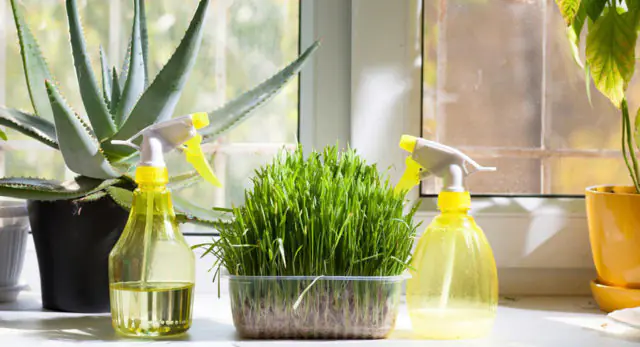
The best way to measure the humidity in a room is to use a hygrometer. Most devices not only measure the percentage of moisture in the air, but also the temperature in the room. However, it is possible to assume that the air is excessively dry without using a hygrometer or barometer. General signs that indicate insufficient room humidity:
- wilting of domestic plants;
- deterioration of the condition of furniture;
- the formation of static charges when touching a person or object;
- dry skin, flaking and itching;
- frequent colds and dry cough;
- constant state of drowsiness and lack of concentration;
- periodic causeless nosebleeds;
- in a dream, a person “whistles” due to dry mucous membranes;
These signs are the main ones, in addition to them there may be deterioration of vision, pain in the eyes due to insufficient hydration of the mucous membranes. These are the consequences of the fact that the body not only does not receive water from the atmosphere, but also gives it away itself. At first, minor deterioration in well-being accumulates and ultimately leads to serious health problems.
The relationship between dry indoor air and health
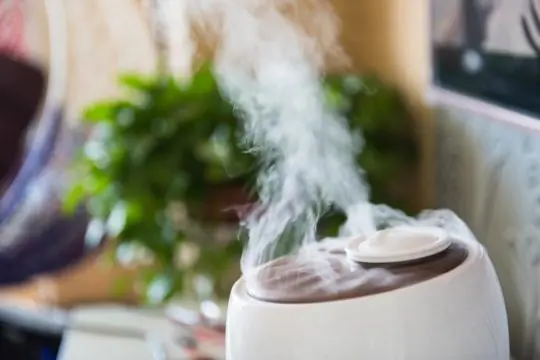
Dry air in an apartment or house is dangerous to health, as it causes a slowdown in the process of transporting oxygen in the bloodstream. When the microclimate is excessively dry, it is difficult to inhale enough air to ensure normal functioning of the circulatory system.
Read also↓↓↓ 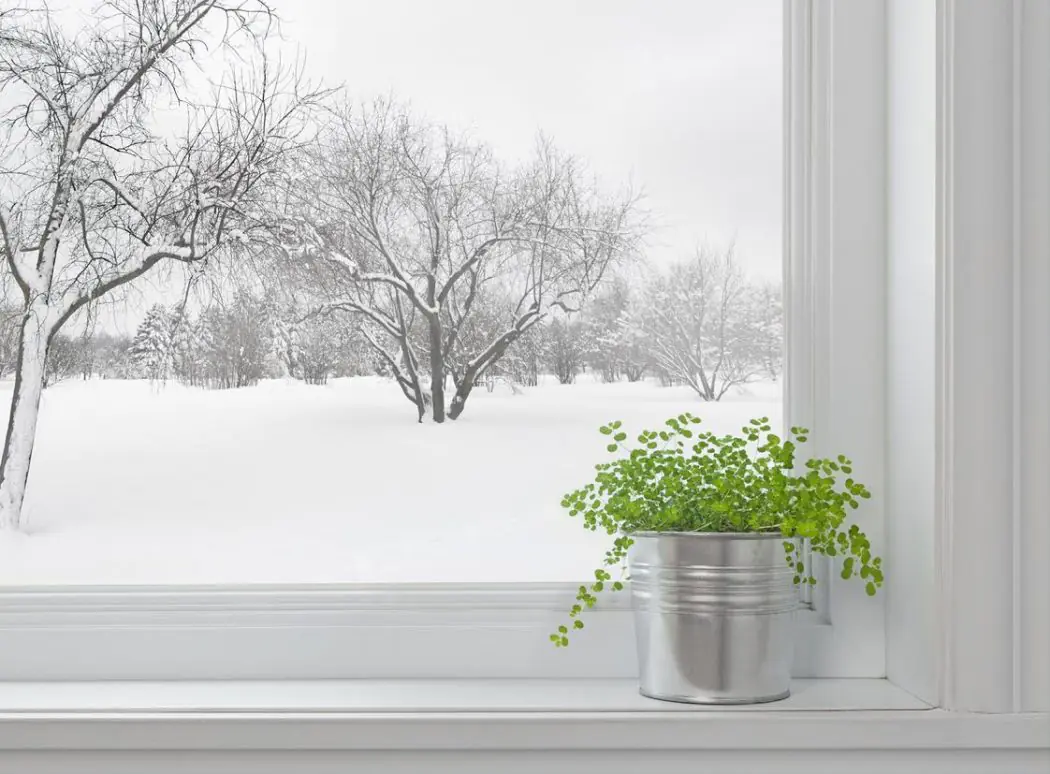
This causes inhibition of the flow of oxygen into the bloodstream and the result is this:
- increased fatigue;
- drowsiness;
- inability to concentrate;
- general depression;
- reduced performance.
When there is low humidity in the room, the mucous membranes begin to dry out. First, the mucous membranes of the nasal passages dry out. This leads to a decrease in local immunity and less resistance to viruses and infections. People living in apartments and houses with low air humidity often get sick and have a harder time recovering from illnesses. Dryness is especially dangerous for young children whose immunity has not yet been fully developed. In addition to the above, a hydrometer mark below 40% leads to the following consequences:
- Premature aging of the skin, which is manifested by the appearance of early wrinkles due to a decrease in the elasticity of the dermis.
- Circulation of dust throughout the premises leads to its entry into the respiratory tract, which leads to frequent allergies and potentially contributes to the development of bronchial asthma.
- The mucous membranes of the eyes dry out, a big problem for people with visual impairments. When wearing lenses, it is necessary to frequently moisturize the eyes with special solutions, as there is a risk of pathological changes in the mucous membranes of the visual organ.
Dry air poses an increased risk to health, and is not just a source of discomfort. Health problems that are considered minor inconveniences can lead to serious health problems in the long term. A low hygrometer level, which does not change for months, leads to deterioration of vision and the development of serious pathologies of the circulatory and respiratory systems.
Lack of humidity and interior
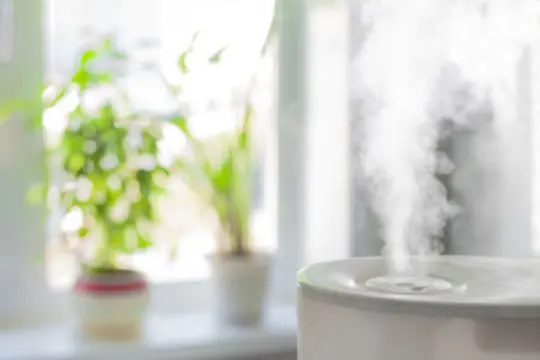
Dry indoor air also negatively affects the environment. There is a lot of dust in the house, which settles on all surfaces and eats into furniture upholstery. In addition to the above, dust particles constantly settle on the floor and owners have to do wet cleaning more often. At the same time, constant exposure to water on floor coverings leads to rapid wear and tear of their “safety margin”.
Musical instruments with wooden inserts become unusable. The wood cracks and the sound of the instrument deteriorates.
Wooden pieces of furniture begin to dry out and become deformed, which worsens the appearance of the room and forces you to spend more money on updating the decor. In addition, laminate and parquet begin to dry out under the influence of dryness, become deformed and become covered with cracks. Houseplants begin to dry out, since most ornamental crops like normal humidity or above average. The result is their yellowing and gradual fading.
Causes

The best indicator is considered to be a hygrometer mark within 40-60%. The most negative impact on the body is less than 30%. At the same time, dry air in an apartment or house is a common problem. And the situation gets much worse in the winter season. There is a common list of reasons that lead to excessive dry air in a room:
- Air conditioners maintain the desired temperature in the room, but very dry the air. In the summer season they are the main reason for insufficient humidity. If the air conditioner has a heating mode, then they deprive the air in the room of moisture even in winter.
- Weakness of ventilation - an undeveloped system of outflow and inflow of air masses leads to a lack of natural circulation in the home.
- Centralized heating - in winter it leads to a strong drop in humidity in the home, since it is impossible to control the temperature in the room.
- A large number of people in a small area of an apartment, house, office. By exhaling carbon dioxide without ventilation, the humidity in the room drops. The situation is further aggravated by the fact that the skin absorbs moisture from the air.
- Lack of ventilation - regular opening of windows and vents guarantees a healthy microclimate in the room. If you periodically ventilate the premises, the volume of bacteria and viruses in the home decreases.
Prolonged ventilation of the home in cold weather leads to an even greater decrease in humidity in the room. This is the main reason why it is not recommended to ventilate rooms in winter for more than 5-10 minutes.
Determining humidity at home
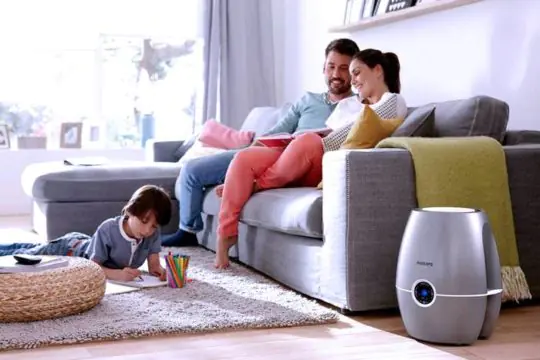
A hygrometer is a device that measures air humidity. It displays the volume of water vapor in the room. To increase the reliability of the readings, it is necessary to place the device away from heating devices and sources of moisture. There are certain criteria that display normal humidity levels for rooms for different purposes - they are listed in the table.
| Room | Index |
| Children's | 60-70% |
| Living room | 40-60% |
| Adults' bedroom | 50-70% |
A hygrometer is not always available, so there are ways to determine approximate humidity values without using a device. To do this, you need a container filled with water. It is placed in the refrigerator for 5-8 hours. Due to the difference in temperature, condensation forms on the walls of the vessel. When the outer surface of the container dries quickly, this indicates over-dryness (the indicator needs to be increased); when drops of water flow down slowly, this indicates normal humidity. If a puddle appears under the vessel, then there is high humidity in the room. In the latter case, it is necessary to reduce the indicator, since the risk of fungi increases.
How to quickly humidify the air in your home
When humidity is low, the only solution is to increase this indicator. Otherwise, the well-being of everyone living in the apartment or house will gradually deteriorate. There are specialized devices that increase the humidity level, but there are also other options for correcting the situation. What to do to increase the humidity level in your home:
- Wet cleaning – it is advisable to wipe dust and floors daily. This increases humidity and removes dust that has settled during the day, which reduces the likelihood of developing respiratory tract diseases.
- Ventilation – it is necessary to open the vents or windows two to three times a day and leave for 10 minutes.
- Moistened fabric - drying washed linen and clothes is a good way to improve the microclimate of your home. As a substitute, you can place a wet cloth close to heat sources.
- House flowers simultaneously release oxygen ions, purify and humidify the air. Schefflera, dracaena, ferns, fatsia, ficus and monstera have this ability. And they advise placing them around housing to improve the microclimate.
- Interior items - an aquarium will not only add a “zest” to the design of your home, but will also maintain a normal level of humidity in the room. It is recommended to place aquariums in children's rooms and living rooms.
There are other ways to increase humidity. To increase this indicator, you can place wide vessels with water near heating sources, periodically use a spray bottle, or throw a wet cloth over the fan. In children's rooms, it is better to place non-poisonous indoor flowers, hang a damp towel and carry out daily ventilation and wet cleaning.
Humidifiers for home use
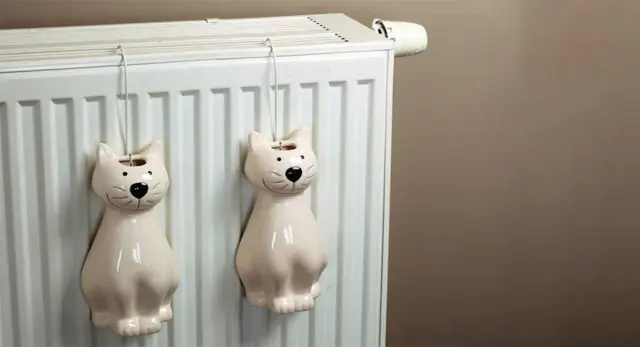
When the problem of dry air in a home is acute, for example, someone has a tendency to allergies, then you need to buy a special device - a humidifier. There are 3 main types - steam, traditional and ultrasonic. Each type has advantages and disadvantages that should be fully considered before purchasing. The table contains comparative characteristics of common humidifiers.
| View | Structure | Advantages | Flaws |
| Traditional | Water container, filter and fan | Low electricity consumption, evaporation completes when optimal humidity is reached, does not break down when water is completely consumed | High frequency of replacement of filter components, it is necessary to use exclusively distilled or purified water, humidity cannot be adjusted (when the mark reaches 60%, the humidifier turns off automatically) |
| Steam | Water tank, fan, heating element, steam chamber, steam sprayer | Rapid increase in humidity levels, the ability to use tap water, no need to change filters, when the liquid boils away the device automatically turns off | Possibility of accidental burn due to carelessness, high energy consumption |
| Ultrasonic | Sprayer, vaporization chamber, ultrasonic membrane, fan, water tank and liquid softening chamber | Compact, economical, safe, ability to adjust humidity levels, rapid increase in performance, low price | Marks appear on the surface when pouring tap water |
All types of humidifiers are quite compact, but there are also built-in systems that are made of several devices that purify and humidify the air to a level specified by the owner. Some air conditioners also come with humidifiers. But, it is necessary to observe the measure and not increase the humidity in the living room above 70%. This indicator can also lead to diseases due to the creation of a favorable environment for pathological microflora.
Conclusion
Excessively dry air in your home is harmful to your health and environment. Humidity below 40% not only leads to a slight deterioration in health, but also creates fertile ground for the development of serious diseases. Interior items made of wood dry out, parquet and laminate are deformed, and dust eats into fabric upholstery. You can increase the humidity using simple methods or buy a humidifier. But it is important to ensure that the hygrometer mark does not exceed 70%.
Heating appliances dry out the air greatly in winter. And this has a bad effect on you and on plants, books, furniture. But don't rush to the store to buy a humidifier. You can solve the problem using available tools.
In winter, the humidity level in the apartment drops to 15–20%. And that's bad. Why?
Firstly, because dehydrated air dries out the skin and mucous membranes, contributes to a decrease in immunity and the development of diseases such as sinusitis and sinusitis. By the way, young children are especially sensitive to its effects.
The second reason is that insufficient humidity harms plants, books, wooden furniture and musical instruments.
The optimal humidity level in an apartment is about 40–60%.
You can measure air humidity using a special device - a hygrometer. If you don't have one, use the following method. Fill a glass with cold water and leave it in the refrigerator until the temperature of the liquid drops to 3–5 °C. Then take out the glass and place it in a room away from the radiators. Observe the glass surface for five minutes. Evaluate the result this way:
- If the walls of the glass first fog up and then dry out after five minutes, the air in the room is dry.
- If after five minutes the glass remains foggy, the humidity is average.
- If streams of water appear on the glass, the humidity is increased.
Is the air dry? Then use one of the following techniques to restore normal humidity levels.
1. Use the bathroom
Probably one of the easiest ways. Leave the door to your room open every time you shower or bathe. Evaporation will penetrate into the apartment and humidify the air.
You can also not immediately drain the water from the bath, but let it cool first: this will increase the amount of steam.
2. Dry things in the room
Another way that doesn’t require any effort on your part. Just place the dryer with washed clothes next to the radiator: the clothes will dry faster and the air will be saturated with moisture.
The main thing is that there are no cleaning products left on things. Otherwise you will breathe chemicals.
A similar way to humidify the air is to hang wet towels on the radiator. You can increase the lifespan of such a humidifier using a water bottle.

freee.ru
How to build such a structure is described in detail here.
3. Boil
All you need is a stove and a saucepan or kettle.
- Option 1. Bring water in a saucepan to a boil and place it on a table or windowsill so that the steam humidifies the apartment.
- Option 2: Boil the kettle and leave it on low heat for longer evaporation. This technique can be used when you are preparing food (the air often becomes dry at this time).
You can also add a few drops of tea tree or eucalyptus oil to the water. Their aroma is soothing, and the vapors kill germs and reduce the risk of colds and flu. In addition, you can throw cinnamon sticks, herbs or other spices into the water to make the air fragrant.
4. Place containers of water around the apartment
You can do without boiling. Simply fill vases, bottles and other containers with water and place them near heat sources. If you add stones and flowers, you will get a beautiful composition - guests, most likely, will not even realize that these are not decorative elements, but homemade humidifiers. Just remember to periodically wash the containers and change the water.
>




